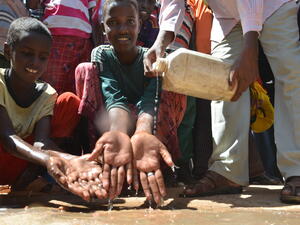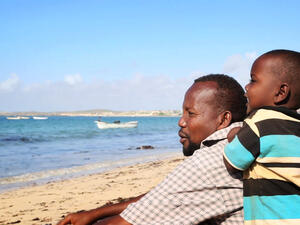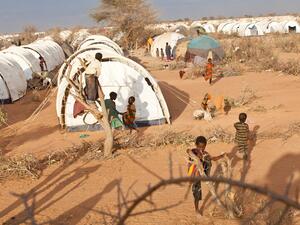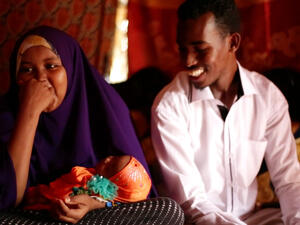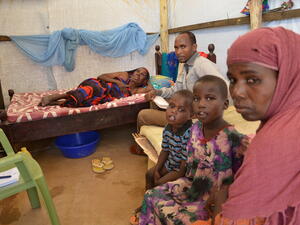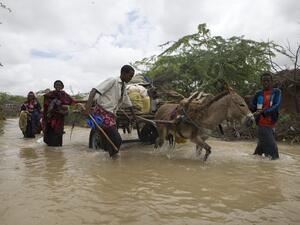Flow of refugees from Somalia to Kenya shows no sign of abating
Flow of refugees from Somalia to Kenya shows no sign of abating

Newly arrived Somali refugees wait to register in the dusty Kenyan border town of Liboi before being transferred to a camp in Dadaab.
LIBOI, Kenya, September 29 (UNHCR) - Somali refugees continue to stream into north-east Kenya, with a daily average of 200-300 people crossing the border to escape fighting in their troubled homeland.
Since the beginning of the year, over 25,000 Somalis have fled conflict in south and central Somalia and arrived in Kenya - including more than 5,000 in September alone.
More than 60 percent of the past month's arrivals are under the age of 18, and many of the families are headed by women. The refugees say males stay behind to take care of other family members unable to leave and to look after family businesses or property.
The refugees are fleeing Mogadishu, Somalia's capital, and the Kismayo area following repeated clashes between the Islamic Courts Union and warlord militia. Others fled the Baidoa area, seat of Somalia's interim government.
The risks of flight are great. "I and my granddaughter came from Kismayo by road and along the way we were robbed by bandits," said 56-year-old Amina, who ran away and made her way to the Liboi crossing point because she thought more fighting was inevitable.
"They took all our food and personal belongings. We had a lot of problems on the way to Kenya," added the exhausted Amina, who was carrying four-year-old Sahara. The woman did not know where the rest of her family was.
"I walked for 45 days. I fled because of the violence in Somalia," said another refugee, Rashid, who made his way with his wife and three children to Liboi from Mogadishu.
The majority of those fleeing to Kenya continue to cross at hot and dusty Liboi, where the sound of crying, thirsty children punctuates the air. After screening them at the border, UNHCR transports the refugees to Dadaab, a complex of three camps already hosting 134,000 refugees - mainly Somalis.
Some refugees are also beginning to arrive at a second border crossing at Amuma, some 80 kms south of Liboi. Others are also going directly to the Dadaab camps without passing through the two main border points.
On Wednesday, UNHCR got approval from provincial authorities to set up a reception centre in the site of an old transit facility in Liboi. "We are still using temporary reception structures which were set up in a compound also housing the Kenyan police and the immigration services," UNHCR spokeswoman Jennifer Pagonis said in Geneva.
Construction materials for the new reception centre have been sent from Nairobi and are expected to arrive in Dadaab soon. UNHCR has also received additional stocks of domestic supplies sufficient for up to 25,000 new arrivals. Until now, because of insufficient stocks, distribution of household supplies has been limited to the most vulnerable families. There is still an urgent need of clothes for the new refugees. Children, especially, are wearing tattered clothes after walking long distances for weeks with only the clothes on their backs.
A team of medical experts from Kenya's Ministry of Health as well as from the World Health Organization visited Liboi and other border areas on Wednesday. They pledged to provide additional health workers to ensure proper screening for communicable diseases among the refugees, as well as immunisation or treatment against polio, measles and tuberculosis for all newly arrived refugee children under the age of five.
But needs are still great. "We are grateful for the support we are receiving from the donors, including the UN's Central Emergency Response Fund and the German government. We, however, need additional funding to be able to cope with the growing number of refugees in the camp" said Eddie Gedalof, acting UNHCR representative in Kenya.
UNHCR is currently working to expand the three existing camps in Dadaab to make room for another 25,000 people as more refugees keep crossing from Somalia.
By Emmanuel Nyabera in Liboi, Kenya


